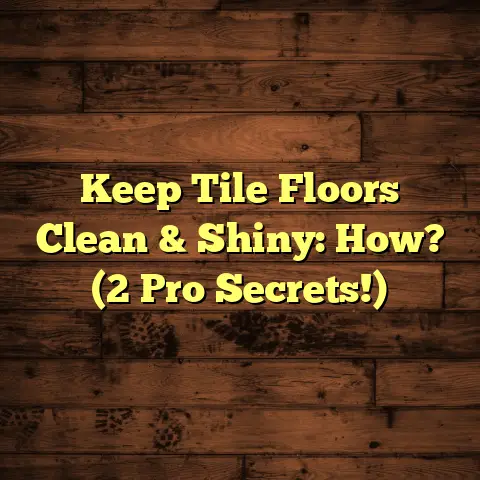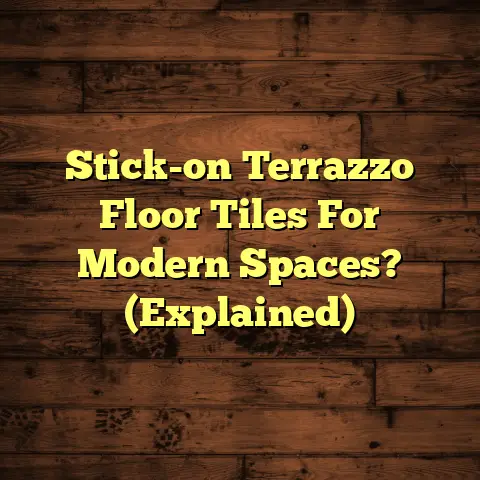Felt Paper Under Hardwood? (Urgent Warning!)
Flooring, man, it’s more than just something
you walk on.
It sets the tone for your entire home.
Think about it: movie nights with the fam, the kids
building Lego empires, or even just your furry pal
doing zoomies across the living room.
Hardwood’s a classic choice, right?
Timeless, beautiful, and adds value.
But here’s the thing: what’s under that
hardwood is just as crucial as the wood itself.
That’s where the underlayment comes in, and
felt paper is often thrown into the mix.
But is it the right choice?
This article is going
to dive deep into the world of felt paper under
hardwood, and I’m here to give you the
straight goods, based on my years in the
flooring trenches.
Let’s get started!
Section 1: Understanding Felt Paper
1.1 Definition and Composition
Okay, so what is felt paper, exactly?
Well, in the flooring world, it’s basically a
paper-like material, usually made from recycled
paper fibers, mixed with other materials to give
it some body.
Think of it as a thick, absorbent
sheet.
It’s been around for ages, and you’ll
find it used in all sorts of construction projects.
It’s often used under roofing to provide a
water-resistant barrier, but it’s also been
used as an underlayment for flooring.
The idea is that it can help protect the
flooring from moisture and add a bit of cushion.
1.2 Types of Felt Paper
Now, not all felt paper is created equal.
You’ve got your roofing felt, which is designed
to withstand the elements, and then you’ve got
flooring felt, which is typically thinner and
less robust.
Flooring felt is specifically designed to be placed
under flooring materials.
It is intended to offer
a smooth surface for the flooring to rest on.
It also helps to reduce noise and provide a
slight amount of cushioning.
The key difference is the level of moisture
resistance and thickness.
Roofing felt is treated
to repel water, while flooring felt is more about
providing a smooth, even surface.
You want to
make sure you’re using the right type for the job.
1.3 Intended Purpose in Flooring Installations
So, why even use felt paper in the first place?
The idea is that it serves a few purposes:
-
Moisture Barrier: It’s supposed to help protect the hardwood from moisture coming up from the subfloor.
-
Sound Dampening: It can help to reduce noise transmission, especially in multi-story homes.
-
Cushioning: It adds a little bit of softness underfoot.
But here’s the kicker: while those are the
intended purposes, the reality can be a
whole lot different.
And that’s what we’re
going to get into next.
Section 2: The Benefits of Using Felt Paper
Let’s be fair.
Felt paper isn’t all bad.
There are a few reasons why people still use it.
2.1 Moisture Protection
In theory, felt paper can act as a moisture barrier.
It’s supposed to block moisture from seeping up
from the subfloor and damaging your hardwood.
And in certain environments, it can provide some
level of protection.
Think of a very dry climate where moisture isn’t
a huge concern.
In those cases, felt paper might
be enough to do the trick.
But, and this is a big
but, moisture control is absolutely crucial for
flooring longevity.
According to the National Wood Flooring Association
(NWFA), proper moisture control is the single
most important factor in preventing hardwood
flooring problems.
So, you can’t afford to
take any chances.
2.2 Sound Absorption
Another potential benefit of felt paper is sound
absorption.
It can help to dampen noise, especially
in multi-story buildings.
If you’ve got kids running
around upstairs, or you just want to reduce the
amount of noise traveling through your home, felt
paper can offer a small improvement.
It’s not going to be as effective as some of the
specialized soundproofing underlayments out there,
but it’s better than nothing.
However, you really
need to consider if the minimal sound reduction
is worth the risk of potential moisture issues.
2.3 Cost-Effectiveness
Let’s be honest, one of the biggest reasons people
choose felt paper is the price.
It’s one of the
cheapest underlayment options available.
If you’re
on a tight budget, it can be tempting to go with
felt paper to save a few bucks.
But here’s the thing: flooring is an investment.
And if you skimp on the underlayment, you could
end up paying a whole lot more in the long run
to repair or replace damaged flooring.
Sometimes, saving a little money upfront can
actually cost you more down the road.
It’s like that old saying, “Penny wise, pound foolish.”
Section 3: The Dangers of Using Felt Paper Under Hardwood Flooring
Alright, now we’re getting to the heart of the matter.
While felt paper might seem like a decent option on
the surface, there are some serious dangers to
consider before you use it under hardwood flooring.
3.1 Incompatibility with Certain Hardwood Types
Not all hardwood is created equal, and some species
are more susceptible to moisture damage than others.
For example, softer woods like pine and fir are
more likely to warp and buckle when exposed to
moisture.
Even harder woods like oak and maple can
be affected if the moisture levels are high enough.
The problem is that felt paper can actually make
the problem worse by trapping moisture against
the underside of the hardwood.
This can lead
to warping, cupping, and other forms of damage.
3.2 Moisture Trapping Issues
This is the big one.
The biggest risk of using
felt paper under hardwood is that it can trap
moisture between the hardwood and the subfloor.
Think of it like a sponge.
It soaks up moisture,
but it doesn’t necessarily release it.
This creates a breeding ground for mold, mildew,
and wood rot.
And once those things get started,
it can be a nightmare to get rid of them.
I’ve seen countless flooring failures caused
by moisture trapped by felt paper.
According to the EPA, mold growth can begin within
24-48 hours of moisture exposure.
So, if you’ve
got a moisture problem and you’re using felt
paper, you’re basically asking for trouble.
I remember one job where a homeowner had used
felt paper under their new hardwood floors.
Within a few months, they started noticing a
musty smell and the floors were beginning to
buckle.
When we pulled up the flooring, we found
a thick layer of mold growing on the underside of
the felt paper.
It was a costly and unpleasant
situation to fix.
3.3 Compromised Structural Integrity
When moisture gets trapped under your hardwood,
it can compromise the structural integrity of
the entire floor.
You might start to notice
buckling, squeaking, and other issues.
The floors might feel soft or spongy in certain
areas.
And over time, the damage can become so
severe that you’ll have to replace the entire floor.
I’ve seen floors that were only a few years old
completely ruined because of moisture problems
caused by felt paper.
Section 4: Alternative Underlayment Options
Okay, so if felt paper is so risky, what are
the alternatives?
Luckily, there are plenty of
other underlayment options that are much safer
and more effective for hardwood flooring.
4.1 Overview of Alternative Materials
Here are a few of the most popular alternatives:
Foam Underlayment: This is a common choice because it’s affordable and provides good cushioning.
It also offers some level of moisture resistance.Cork Underlayment: Cork is a natural, sustainable material that’s great for sound dampening and insulation.
It’s also naturally resistant to mold and mildew.Rubber Underlayment: Rubber is a durable, long-lasting option that provides excellent sound absorption and cushioning.
It’s also resistant to moisture and mold.
Each of these materials has its own set of
benefits and drawbacks.
Foam is the cheapest,
but it’s not as durable as cork or rubber.
Cork is eco-friendly, but it can be more expensive.
Rubber is the most durable, but it can also be
the most expensive.
4.2 Industry Recommendations
The flooring industry is pretty clear on this:
avoid using felt paper under hardwood flooring.
Most flooring manufacturers recommend using a
vapor retarder with a perm rating of less than 1.
This means that the material allows very little
moisture to pass through it.
The National Wood Flooring Association (NWFA)
also recommends following the manufacturer’s
instructions for underlayment installation.
They also say that you should always test the
moisture content of both the subfloor and the
hardwood before installation.
I always tell my clients to err on the side of
caution.
It’s better to spend a little extra
money on a high-quality underlayment than to
risk damaging your hardwood floors.
Section 5: Real-Life Examples and Case Studies
Let’s take a look at some real-life examples of how felt paper has performed under hardwood flooring.
5.1 Case Study Analysis
Case Study 1: The Buckling Oak Floors: A homeowner in Ohio installed oak hardwood floors with felt paper underlayment.
Within two years, the floors began to buckle and cup.
Upon inspection, it was found that the felt paper had trapped moisture from a minor basement leak, leading to significant damage.Case Study 2: The Moldy Maple Floors: A family in Florida installed maple hardwood floors with felt paper.
The high humidity in the area caused moisture to accumulate under the felt paper, resulting in mold growth and a persistent musty odor.Case Study 3: The Squeaky Pine Floors: A homeowner in California installed pine hardwood floors with felt paper.
The floors began to squeak within a year.
It was discovered that the felt paper had compressed and deteriorated, providing inadequate support for the flooring.
5.2 Lessons Learned
These case studies highlight the risks of using
felt paper under hardwood flooring.
The key
lessons learned are:
-
Moisture is the Enemy: Always prioritize moisture control when installing hardwood floors.
-
Felt Paper Can Trap Moisture: Avoid using felt paper in areas with high humidity or potential moisture problems.
-
Choose the Right Underlayment: Select an underlayment that is specifically designed for hardwood flooring and that provides adequate moisture protection.
Conclusion: A Call to Action
So, there you have it.
While felt paper might
seem like a cheap and easy solution for
underlayment, it’s simply not worth the risk.
The potential for moisture damage, structural
problems, and incompatibility with certain
wood types is just too great.
Protect your investment by choosing a safer,
more effective underlayment option.
Talk to a
flooring professional, do your research, and
make sure you’re making the right choice for
your home.
Your floors will thank you for it!





